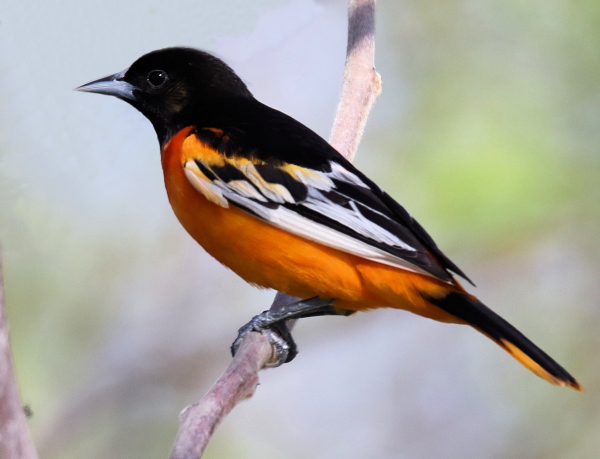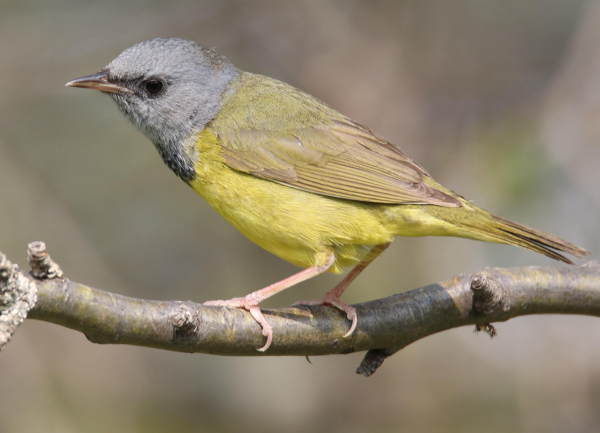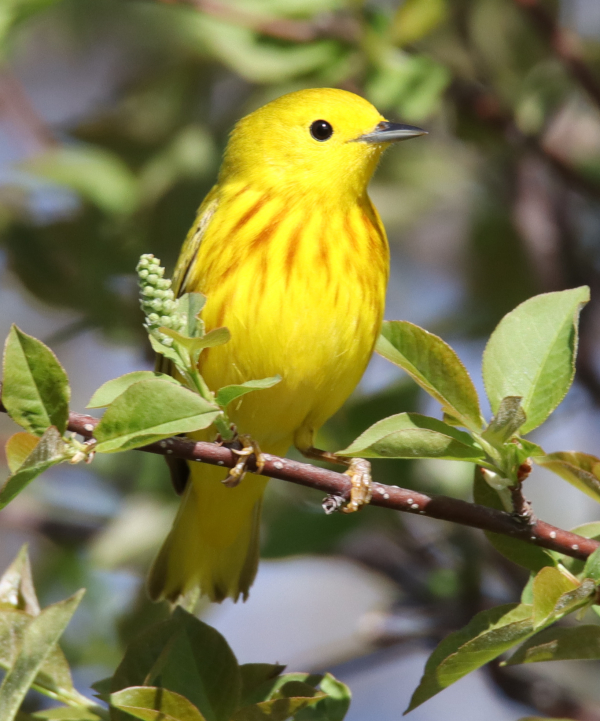
A portrait of the white-winged Baltimore Oriole shows the extent of albino feathers on its left wing. Paul hopes the unique oriole will spend the summer utilizing his oriole feeder and the surrounding landscape.

A morning thrill yesterday was a chance to photograph a Mourning Warbler – twice. The story is provided in this week’s Bird Photography feature.

For a species that usually prefers to be hidden among low vegetation, this Mourning Warbler provided a few opportunities to photograph it in the open.

Shining bright in the morning light, this male Yellow Warbler added color and song to The Grove yesterday (Tuesday).
|
What a dramatic change in the avifauna Wednesday! It started with a sighting of an Orange-crowned Warbler and a first of spring female Orchard Oriole. Shortly thereafter, a first male Baltimore Oriole appeared at my feeding station, soon followed by a male Orchard Oriole, no less than 8 American Goldfinches at a time, and a first Gray Catbird – what fun! I also observed the first Ovenbird, Least Flycatcher, and Chimney Swifts – all from home during a mostly rainy day. Not that I didn’t check on my nearby migration fallout site, Melody’s Grove, but that day my yard was the hotspot, in spite of the rainy weather. Actually, even though Melody’s Grove was quiet, across the road behind my grandparent’s house, a flock of 8 regal Harris’s Sparrows was foraging on the ground.
As the light rain continued Saturday, at least 7 Orchard Orioles (3 adult males, 1 first-year male, and 3 females) were stopping by for grape jelly, along with at least 8 Baltimore Orioles (4 females, at least 3 typical adult males, but probably more; and remarkably, 1 white-winged adult male!) – that’s a minimum of 15 orioles.
The white-winged adult male Baltimore Oriole is an exceptional individual for 2 reasons: First, this male shows a slight level of albinism in that some feathers on its left wing are pure white, some are partly white. This makes it a partial albino, or leucistic Baltimore Oriole. The unique white coloration on the wing also makes it readily identifiable – it’s essentially a marked bird. And that leads to the second very surprising part of this unique oriole’s arrival – this white-winged oriole visited my feeder last year from August 26th to 28th; after the nesting season, so probably as it was heading south.
I reported the unique white-winged oriole in my Editor Afield article in the August 31 issue of The Birding Wire and included a couple photos, while here I provide a photo I took Sunday for you to see the white feathers on its left wing. I was dumbfounded when I saw the white-winged oriole first thing Saturday; it obviously found its way back to my feeding station 8 months after I first saw it, undoubtedly having spent most of that time somewhere between Mexico and Columbia. It makes me wonder how many of the other orioles have been here before and are returning.
In the Field
The real change in the field began where I left off in last week’s Editor Afield article, when I shared the appearance of a number of first sightings at the old farmhouse fallout site about 11 miles south on Sunday, May 7th. That’s when I reported the first of spring Yellow Warblers, a Black-and-White Warbler, a Northern Waterthrush, Orange-crowned Warblers, a Say’s Phoebe, and Song Sparrows, with many Swainson’s Thrushes on hand.
When I returned the following morning I observed a Yellow Warbler, a Black-and-White Warbler, the first Blackpoll Warbler and Barn Swallows, and at least 2 Say’s Phoebes. But I was hoping to see more after the clouds cleared overnight, and given the number and variety of songbirds on hand the night before. Even so, I found a pair of Northern Flickers using an excavated cavity in a snag adjacent to the farmhouse itself. Beyond the farmhouse site I observed the first of spring Western Kingbirds, Wilson’s Snipe, Clay-colored Sparrows, and an Upland Sandpiper – so there was something of a migration overnight.
Following up the next day, the farmhouse site was quiet aside from the pair of Northern Flickers and many Barn Swallows, but beyond the hotspot I observed the first of spring Eastern Kingbirds, American Goldfinches, and Black Terns, along with the first White-faced Ibis and Great Egret that I’ve seen in the local region. There were also more Western Kingbirds and Upland Sandpipers on hand.
Then, to my surprise, along a fenceline on the open prairie I found a flock of Yellow-rumped Warblers numbering more than 20 that included adult males and females, along with first-spring Yellow-rumps with a male Yellow Warbler and a Palm Warbler in their midst. Unlike any other warbler encounter that I can remember, this loose flock was not associated with trees. Instead they perched on barbed wire fences from which they flew out to catch nearby insects in flight or on the ground. The fences paralleled the remote roadway and a ditch filled with shallow water, which appeared to create most of the small insect action. I photographed a few of the warblers and enjoyed the experience of seeing this unusual stopover behavior.
Back Home
In addition to the exciting oriole activity described above for rainy Saturday, other highlights included a first-ever sighting of a Chestnut-sided Warbler in my yard, a young male. The new species appeared on the lowest branches of the elm tree adjacent to my feeding station, and was soon joined by an even smaller Ruby-crowned Kinglet to forage among the new buds, branch after branch – then they were gone.
The warmth and sunshine that Sunday afternoon provided may have contributed to the arrival of the first Ruby-throated Hummingbird at my nectar feeder, a female, although she appeared to be a lone arrival, and seemed to be put off by the considerable oriole activity – even though the nectar feeder is offset from the others by 6 feet or so. I’m patiently waiting to witness the second hummingbird, and many more – it’s still a bit early for hummers, but any minute now.
Mini-Fallouts
Expecting a big overnight migration, as forecast by BirdCast, and with the first bird of the day outside my windows a rarely seen male Rose-breasted Grosbeak, Monday morning I eagerly headed to Melody’s Grove to check for new birds. The Grove had not yielded a sign of a single migrant yet, so it was nice to see some pretty immediate action – the first female Common Yellowthroats, Brown Thrashers, and House Wrens, plus Yellow Warblers, male Orchard Orioles, female Baltimore Orioles, a couple Ruby-crowned Kinglets, Lincoln’s Sparrows, Gray Catbirds, Least Flycatchers – a nice start to the migration season on May 15th.
I also checked out the farmhouse hotspot, but there was not a songbird to be found; just Barn Swallows, Tree Swallows, and the male Northern Flicker poking its head out of the apparent nesting cavity. Before parking my car when I returned home, I noticed an Ovenbird foraging on the ground under the far end of my chokecherries. Once in my office, I witnessed an almost continuous assault on my jelly feeders by orioles, especially Orchard Orioles, that numbered as many as 7 at a time. I’m happy to say that I’ve never attracted so many Orchard Orioles during migrations, and I’m doubly happy to report that the white-winged Baltimore Oriole was back for a fourth day of feeder visits and songs. Sure hope he stays!
Tuesday morning I was less excited about the chance of a fallout, yet the first bird was a Mourning Warbler that initiated an exciting birding episode that I relate in the Bird Photography article in this issue. Other newbies included a couple Magnolia Warblers and a Red-eyed Vireo, plus a pair of Rose-breasted Grosbeaks, an Orange-crowned Warbler, a couple Yellow Warblers, and a few female Yellow-rumped Warblers. These species indicate that the second group of songbird migrants is beginning to arrive, overlapping with the first group. This second group and the third group to follow will make the remaining days of May most exciting. Enjoy the new migrants as they arrive daily!
Article and photos by Paul Konrad
Share your bird sightings and photographs at editorstbw2@gmail.com